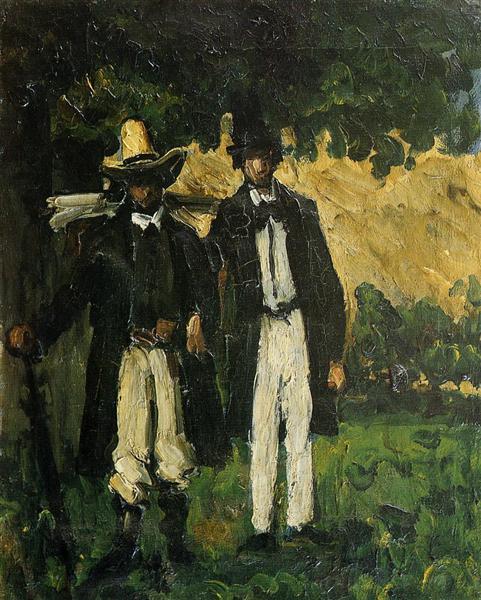Description
Paul Cézanne's "Marion and Valabregue Posing for a Photograph" (1866) is a notable example of the transition from academic art to the modern expressions that would mark the rise of Post-Impressionism. In this painting, Cézanne captures an intimate moment that, at first glance, might seem anecdotal, but which actually encapsulates the complexity of the artist's technique and sensitivity.
In the composition, two figures stand out in a natural setting, where light and colour play a crucial role. On the left, Marion, in a light dress, stands in a contrasting tone against the darker, earthier background. At her side, Valabregue, dressed in dark colours, seems a counterpoint to the luminosity of his companion. The relationship between the two characters, seemingly in a state of pause, suggests an intimate connection, highlighted by the physical proximity and almost natural attitude of the models. One can perceive that they are aware of the observer, although they do not pose rigidly; rather, their postures suggest the spontaneity of a moment captured in the transition between portrait and instant effect.
Cézanne is known for his focus on structure and form, and here those traits are cleared away through the simplification of the figures and use of short, grouped brushstrokes that characterize his style. Although the sitters' faces do not display the photographic realism that earlier masters of portraiture might have cultivated, the freshness of their expressions and evidence of an inner life reveal a deep psychological understanding of his subjects. Rather than following the classical ideal of beauty, Cézanne delves into the everyday, capturing the essence of the moment.
As for the palette, earthy tones and blues dominate the background, creating a natural atmosphere that contrasts with the delicacy of the characters’ clothing. The nuances in the color suggest the fragility of daylight, while Cézanne’s brushstroke technique adds an almost tactile vibrancy, evoking a sense that the scene could change with just a movement. His approach to color as a means of expressing light, rather than following traditional rules, transforms this work into an exploration of the nature of human perception.
This painting also illustrates Cézanne's quest to break down forms and represent them from multiple perspectives. The configuration of the subjects and their surroundings reflects his concern with geometry and the construction of pictorial space. Through the interplay of figures and the clever use of negative space, Cézanne not only captures a portrait of two people, but also poses a dialogue about the relationship between the individual and their context.
"Marion and Valabregue Posing for a Photograph" comes at a significant moment in Cézanne's career, when he was beginning to distance himself from academicism and forge a unique style that would influence generations of later artists. Often overlooked in comparison to his more recognizable works, such as still life compositions or landscapes, this work offers us a revealing insight into his evolution as a painter. The potential simplicity of the subjects should not deceive us; on the contrary, it is a testament to his mastery in capturing life in its most essential form, a form that continues to resonate in contemporary art.
KUADROS ©, a famous painting on your wall.
Hand-made oil painting reproductions, with the quality of professional artists and the distinctive seal of KUADROS ©.
Painting reproduction service with satisfaction guarantee. If you are not completely satisfied with the replica of your painting, we will refund 100% of your money.

